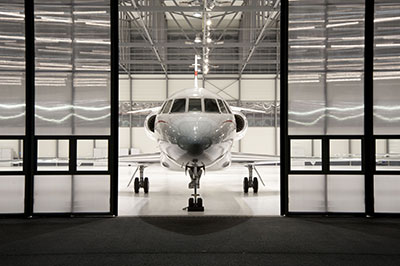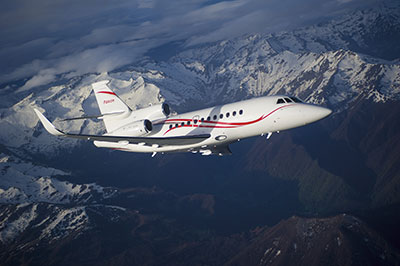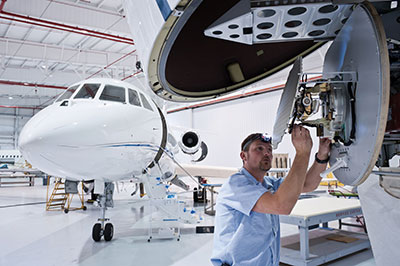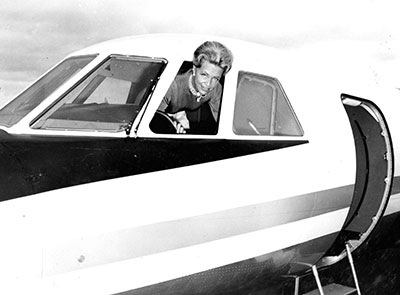
Features
Business Aviation
The Dassault Falcon legacy
On April 1, 1963, the first Mystére 20 (since renamed the Falcon 20) rolled off the assembly line in Bordeaux, France. It was company founder Marcel Dassault’s first true purpose-built business jet.
September 9, 2013 By Brian Dunn
On April 1, 1963, the first Mystére 20 (since renamed the Falcon 20) rolled off the assembly line in Bordeaux, France. It was company founder Marcel Dassault’s first true purpose-built business jet. Some 20 different models have followed in the years since that launch 50 years ago, and Dassault Falcon continues to raise the bar in the world of business aviation development.
 |
|
| The Falcon 2000LX in the new Dassault Aviation Falcon demonstration hall. Photo: Dassault Falcon
|
The Mystére 20 was based on technologies designed for the Mystére IV fighter and it looked more like an airliner than an executive aircraft. Today, more than 2,250 Falcons have been delivered to 82 countries around the world and they have accumulated more than 16 million hours of flying time.
Dassault’s first business jet design, the Méditerranée, was created on paper in 1954 and featured two jet engines under the wing. Although ahead of its time, the idea was abandoned due to potentially high production costs and high fuel consumption.
On May 4, 1963, just before its maiden flight, a Pan American World Airlines delegation headed by Charles Lindbergh inspected a Mystére 20 prototype. Lindbergh had been mandated by CEO Juan Trippe to find the right aircraft to equip Pan Am’s new executive aviation division. After the inspection, Lindbergh wired Trippe declaring, “I’ve found the bird” and Pan Am became the launch customer for the new aircraft.
Two years later, test pilot Jacqueline Auriol set a new world speed record, flying the first production Mystére 20 for 1,000 kilometres at a speed of 859 km/h.
Why simple is better
In 1966, Pan Am decided to use an American name, judging it more attractive for its clientele. After briefly considering “Baby Jet,” it decided on Fan Jet Falcon, which later became, simply, Falcon 20. The Falcon designation took hold in the U.S. and in most parts of the world. Falcon 10, Falcon 50, Falcon 100, Falcon 200 and Falcon 900 soon followed in a family-like imitation of the Falcon 20 nomenclature. The French still generally use Mystére 20 for the time-honoured Falcon 20, but called later models Mystére-Falcon 10, Mystére-Falcon 50 and so on. The Falcon 20 was nicknamed “the corporate bullet” by administrative pilots, because the four-to-six passenger aircraft could fly coast to coast across the U.S. with one stop faster than most aircraft at the time that could cross the country nonstop.
 |
|
| With 50 years in business aviation under its belt, Dassault Falcon is hardly resting on its laurels. A new model, code name “SMS,” was set to be introduced at the 2013 NBAA show. Photo: Dassault Falcon
|
In 1971, FedEx founder Frederick Smith selected the Falcon 20 as the fleet for his then-fledgling overnight freight service. The following year, Pan Am and Dassault formed joint venture Falcon Jet Corporation to market and support Falcon aircraft sold in the western hemisphere and other overseas markets. Dassault later bought out Pan Am’s share and changed the company’s name to Dassault Falcon Jet.
The Falcon 50 was introduced in 1976 and was designed to carry eight to 10 passengers across the U.S. or over the Atlantic non-stop. The tri-jet configuration was selected to provide better redundancy, safety and a larger cabin with a pressurized baggage hold. Its exceptional performance and versatility made the Falcon 50 a very popular aircraft at the time. The following year, a Falcon 20 spinoff, equipped with Garrett ATF-3-6 engines, was selected to meet the U.S. Coast Guard’s medium-range surveillance aircraft requirements.
Meeting supplier demands
The next major milestone in the company’s 50-year history occurred in 1984 when the Falcon 900 rolled out in Bordeaux. Unveiled at the 1983 Paris Air Show, the 4,000-nautical-mile Falcon 900 met growing operator demand for a large-cabin business jet with a true intercontinental range.
 |
|
| Dassault Falcon is the largest division of Dassault Aviation, accounting for 71 per cent of the company’s $5.35 billion revenue in 2012. Photo: Dassault Falcon |
Nine years later, on March 4, 1993, the Falcon 2000 flew for the first time, with first delivery in February 1995. It was the first executive aircraft designed by computer and was conceived to meet a growing demand for a transcontinental business jet combining superior performance and cabin comfort with low operating costs.
In October 2000, Dassault introduced its long-awaited 2000EX featuring Pratt & Whitney Canada’s PW308C turbofan engines. It offers almost the same range as the Falcon 900C (roughly 3,800 nautical miles (NM)) with an airframe identical to the 2000. The 2000EX made its first flight in October 2001, with first deliveries in the second quarter of 2003.
On Feb. 22, 2002, the first flight of an EASy-equipped Falcon 900EX took place. Developed in partnership with Honeywell, EASy (Enhanced Avionics System) was designed to improve safety by simplifying flight management tasks, improving crew coordination and ensuring optimal situational awareness at all times.
For the Falcon 7X, the company’s longest range aircraft, first flight occurred on May 5, 2005, in Bordeaux. It was also the first business jet with a digital flight control system. The 5,950 NM aircraft features a new wing, which offers a dramatic increase in lift-to-drag ratio. The aircraft has an MMO of Mach 0.90, allowing quicker climbs and descents, as well as low-level dashes on short legs. It is powered by three PWC 307A engines, rated at 6,400-pound thrust each.
In 2009, it became the largest, longest-range business jet certified to fly into and out of London City, one of the world’s most challenging airports. All in-production Falcons are now approved for London City operations. And in July 2009, the 2000th Falcon jet was handed over to Koç Holding, the largest industrial conglomerate in Turkey. Falcon’s parent, Dassault Aviation, is ranked among the top 50 companies in Europe in terms of sales and is a member of the Fortune Global 200.
Introduced in May 2011, the Falcon 2000S offers a sleek, elegant cabin crafted in collaboration with BMW Group Designworks USA. In January 2012, Dassault and BMW received the prestigious 2011 Good Design Award for this specially designed interior.
To mark the company’s 50th anniversary, a Falcon 20 s/n 1 was recently restored by IT Mercure, a team of enthusiasts who also rebuilt the last Mercure airliner and featured it at the Paris Air Show in June.
Expanding the footprint
Dassault Falcon is the largest division of Dassault Aviation, accounting for 71 per cent of the company’s $5.35-billion revenue last year. Dassault Falcon has 34 service centres globally, including a completion centre in Little Rock, Ark., a maintenance centre in Wilmington, Del., and a repair and overhaul centre in Deerfield Beach, Fla.
 |
|
| Test pilot Jacqueline Auriol set a new world speed record for the Mystére 20 in 1965, flying for 1,000 kilometres at a speed of 859 km/h. Photo: Dassault Falcon
|
Dassault plans to spend $60 million to expand its Little Rock facility in anticipation of its new business jet (code name SMS) which is being introduced at NBAA in October. It is the first all-new Falcon since the launch of the 7X.
All Falcon models have been upgraded. The latest member of the family to get a makeover is the 2000LXS, replacing the 2000LX. The newer version will be offered alongside the new entry-level 2000s in a large-cabin segment, where competitors include the Bombardier Challenger 605 and the Gulfstream G450, and where demand has remained reasonably stable since the financial crisis.
“The 2003-2008 boom market was great for Dassault. The high end grew at the fastest rate and that’s where Dassault plays,” said Richard Aboulafia, vice-president, analysis, of the Teal Group Corporation in Fairfax, Va. In fact, Dassault, the only company that purely plays in the top half, is also the only company to increase its deliveries in 2009 and 2010, he added.
“However, the hard times caught up to Dassault in 2011, particularly as the initial 7X order book was built down. Still, Dassault’s significant new product investments will keep it in good shape to grow as the market recovers.”
The 7X shows a lot of promise in a nice intermediate niche and will be the first business jet with fly-by-wire control, Aboulafia noted. The 7X also will allow Dassault to compete with the Gulfstream 500 and GEx among others on near-equal terms, excluding range, which remains about 1,000 NM below the competition. “We expect the 5X/SMS/Falcon 50 replacement to proceed eventually,” said Aboulafia.“Our forecast calls for it to arrive in 2018, but it seems to be turning into more of a 900 replacement. It will leverage 7X technology and should be a strong performer.”
As the only integrated supersonic fighter/business jet manufacturer, Dassault has the skill and technology to lead a supersonic bizjet (SSBJ) project, suggested Aboulafia, now that the Concorde is gone. It may also consider a new mid-range Falcon, in the same class as the 20/200.
While this is all speculation, Aboulafia emphasized that the Falcon family is in good shape, despite the 2011 and 2012 deliveries slump of 67 and 66 aircraft respectively, down from 95 in 2010. Sales are expected to increase to 70 this year and hit 100 per year by 2020.
“It’s a sign of the times that business jets, once an afterthought to Dassault’s primary business area, saved the company from being marginalized,” he said.
With 50 solid years in business aviation under its belt and a new model imminent, the Dassault Falcon continues to soar in the business aviation market – far from being marginalized indeed.